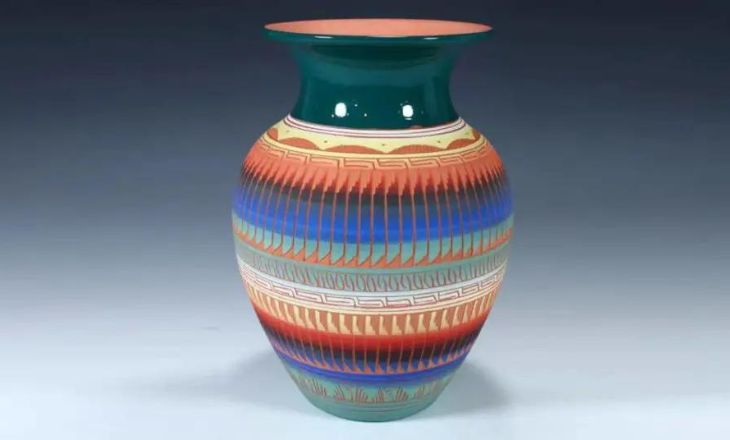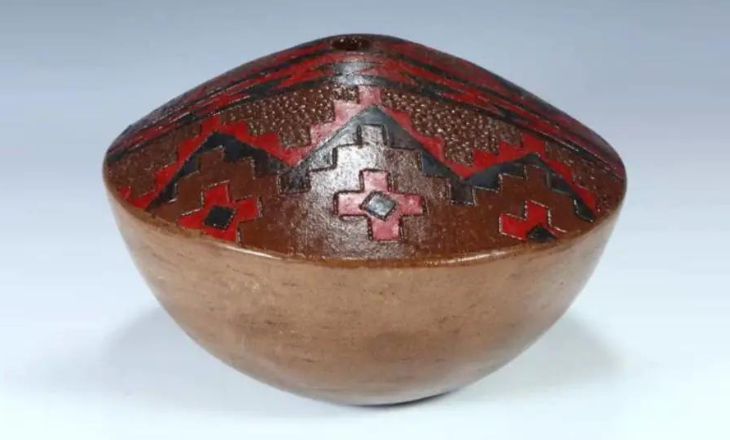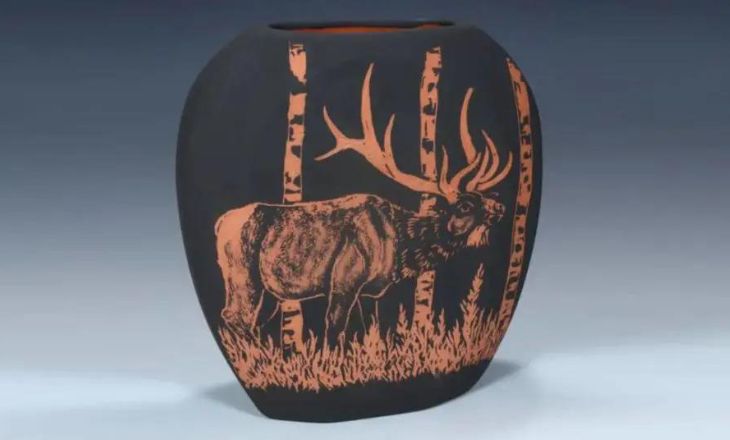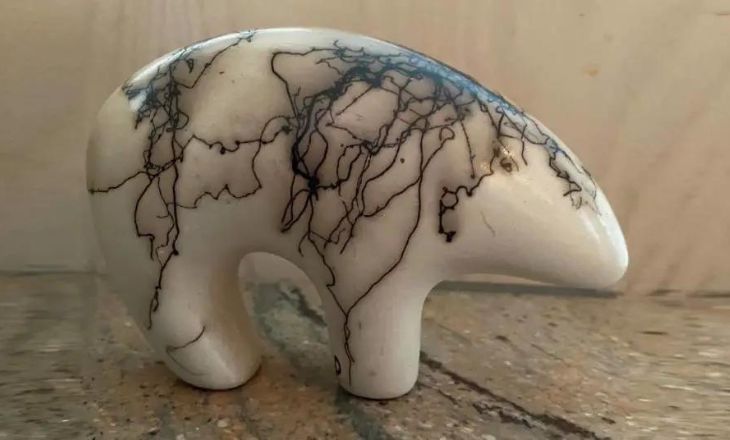From ancient traditions to modern innovations, The world of Navajo pottery is full of amazing patterns and a wide range of styles. The rich past of these one-of-a-kind creations provides a fascinating look into the creativity and craftsmanship of these indigenous cultures.
Navajo designs are a vibrant and intricate art form that reflects the rich cultural heritage of the Navajo people. The striking geometric patterns, bold colours, and symbolic motifs have been a fundamental part of traditional Navajo life for centuries.
In this article, we’ll explore nine Navajo pottery designs that will captivate your imagination and leave you wanting to learn more.
Navajo Etched Pottery
The fascinating display of beautiful designs in Navajo etched pottery is created by dropping the clay into a mould and shaping it using a potter’s wheel. Pottery undergoes a fire process to become a strong work of art after the pattern has been carefully carved into the clay.

During this firing process, vibrant colours emerge from the extreme heat, hardening the pottery and giving it an earthy charm. Highly carved designs are permanently imposed in the strengthened clay, undergoing an amazing transformation.
The fusion of today’s creativity with old techniques produces works that are truly significant and wonderfully magnificent.
Navajo Hand-Etched Horsehair Pottery
The intricate skill of Navajo hand-etched horsehair ceramics is a stunning mix of age-old customs, organic materials, and great artistry. Each piece begins with the bisque stage of clay, where the raw material is shaped and prepared for its transformative journey. When the potter carefully carved elaborate patterns into the clay, it’s time to add the attractive detail of a noble horsehair.
As the piece is fired in traditional outdoor kilns, the horsehair and heated clay mix, dark patterns, and straight lines are left behind that move across the surface. The unique interaction between the heat and horsehair results in stunning visual effects that cannot be replicated through any other method.
Navajo Wedding Vase
The discovery of a two-headed Navajo wedding vase by artist Elaine Begay provides an amazing window into the Navajo people’s ceremonial customs. This vessel’s beautiful layout and fine craftsmanship highlight the importance of such items in traditional ceremonies.
The wonderful items that archaeologists are finding provide information on the symbolic aspects and cultural ceremonies that have been rooted in Navajo traditions.
These findings stimulate reflection on the spiritual importance and age-old craftsmanship worked throughout each carefully constructed vase. These containers have a significant part in celebrating marriages and keeping family traditions, as seen by their ceremonial use.
Coiled Pine Pitch-Carved Pottery
Pine pitch is a type of pottery in which a towel is dipped in boiling water and applied to the surface of the pot. Among the Navajo people, the skill of coiled pine pitch-carved pottery is an age-old tradition that perfectly balances functionality and beauty.
Every curve and line in each piece tells a narrative and reflects the spirit of Navajo tradition and culture. This style is distinguished by the way it effortlessly combines creativity and functionality; each piece is both a beautiful piece of art and a useful vessel. Pine pitch is applied carefully to produce watertight containers.

In embracing this beautiful tradition, we gain not only unique decor for our homes but also a deep appreciation for the culture and history it represents. Through coiled pine pitch-carved pottery, we come to understand the value of artistry in our everyday lives.
Navajo Vase With Incised Petroglyphs
Renowned artist Taipei Navajo creates an amazing blend of tradition and modern art, using effects from the ancient artwork located in Crow Canyon near Farmington. His masterwork, the Navajo Vase with Carved Petroglyphs, is proof of his close connection to his culture and the Southwest’s holy landscapes.
Taipei Navajo carefully incorporates an abundance of symbols and themes from the petroglyphs carved into the rocks in Crow Canyon into his artwork, creating a link between the past and present.
Using his artistic creations, he not only protects the heritage of his predecessors but also renews these old images, allowing us to see their lasting significance in the modern era.
Navajo Etched Wildlife Pottery Plate
Frank Lee, a renowned Acoma Pueblo potter, is known for his exceptional skill in cast mould pottery. His work embraces traditional techniques while incorporating modern design elements, resulting in truly unique pieces.
The influence of Navajo potters can be seen as neighbours to the Acoma Pueblo, with their distinctive etched wildlife pottery plates showcasing a different artistic approach within Native American Pueblo pottery.
Acoma and Navajo potters share a deep connection to their land and natural surroundings, which is often reflected in their art. Frank Lee’s cast mould creations exemplify this connection by incorporating intricate designs inspired by the surrounding environment.
Similarly, With its intricate representations of animals and landscapes, Navajo artisans’ imprinted wildlife ceramic plates capture the spirit of the natural world.
Navajo Etched Wildlife Pottery Pillow Pot
Potter Frank Lee’s unique approach to pottery casting has revolutionized the art form. By utilizing innovative techniques and materials, he has created a super different style of pottery that captivates the eye and challenges traditional norms.

His use of cast moulds allows him to experiment with forms and shapes, resulting in stunning pieces that stand out in any collection. One of Frank Lee’s signature features is his use of terracotta colouring, which brings warmth and depth to his creations.
This distinctive choice sets his work apart from others in the field and adds an earthy, natural element to each piece. His masterful understanding of negative space emphasizes his appreciation for balance and harmony within the artwork.
Each Navajo Etched Wildlife Pottery Pillow Pot from Frank Lee tells a story through its intricate designs and careful craftsmanship.
Navajo Eagle Hand Etched Pottery
In Navajo culture, the eagle holds a prominent role as a symbol of strength, freedom, and spiritual connection. Famous Navajo potter and artist Paul Lansing has masterfully captured the majesty of the eagle in his hand-etched ceramics.
This enjoyed bird’s spread wings and finely detailed feathers serve as a constant reminder of its goodness. For centuries, feathers from eagles have been used in ceremonies and rituals as a way to communicate with the heavens.
The act of offering prayers with eagle feathers is deeply rooted in Native American traditions, symbolizing a direct connection between earth and sky. Lansing’s artwork not only captures the physical beauty of the eagle but also embodies the spiritual significance that these magnificent creatures hold within Navajo culture.
Navajo Horse Hair Ceramic Bear Figurine
The superbly made Navajo horse hair ceramic figures fascinatingly combine imagination and tradition. These one-of-a-kind sculptures get depth and individuality from the black lines that are produced by carefully applying horse hair to the ceramic surface before firing.

The artist carefully shapes the clay into forms that express both the humous and dark aspects of life, requiring a delicate balance of technique and emotion. Collectors are drawn to these perfectly designed figures not just for the way they look but also for the deep cultural importance that each skillfully sculpted detail has.
Accepting this art form invites us to consider the universal concepts of dedication, spirituality, and nature that have been handed down through the ages.
A Brief History Of The Navajo People
Western Canada approximately 1,000 years ago was home to the Athapaskan people, who eventually split into various subgroups, with the Dine being one of them. As their population grew, the Dine migrated southward and settled in what is now known as northern Arizona.
This migration marked a significant shift in their lifestyle and culture, as they adapted to new environments and developed different social structures. Around 1300 A.D., communities on the Northwest Coast flourished due to advanced artwork and trade networks.
The intricate nature of their creative expression and social structure demonstrated the depth and diversity of the cultures that lived in this area. The rich patchwork of cultural traditions that defined the Pacific Northwest during this century was made by the exchange of ideas and resources among these communities.
The history of the Navajo people is deeply intertwined with their interactions with Puebloan neighbours and Spanish missionaries. The Puebloans, who were skilled in agrarian life, shared techniques and resources with the Navajo, fostering a relationship that shaped their communal practices.
Spanish missionaries arrived in the sixteenth century to convert and subdue the native population. This typically involved using cruel methods that caused disturbance and battle.
One of the darkest chapters in Navajo history is marked by The Long Walk, a forced relocation of thousands of Navajo people to Fort Sumner in 1864. This devastating event not only disrupted their traditional way of life but also brought immense suffering and loss as they were subjected to harsh conditions and inadequate provisions at Fort Sumner.
Indian Pottery Design
Bright colours, intricate patterns, and symbolic motifs are expertly hand-painted onto clay vessels, creating a mesmerizing fusion of artistry and functionality. Indian pottery design offers a rich tapestry of styles that reflect the cultural diversity and heritage of the country.
Traditional Navajo pottery Designs
Traditional Navajo pottery designs are manifestations of the tribe’s deep connection to their land and culture. Each piece tells a story, preserving the legacy of generations before. The intricate designs and earthy colors reflect the harmony between nature and art, showcasing the Navajo people’s reverence for their surroundings.
Conclusion
Navajo pottery designs offer a vibrant tradition that reflects the culture and history of the Navajo people. Each design tells a unique story, showcasing the skill and artistry of the Navajo potters.
From traditional geometric patterns to intricate animal motifs, these pottery designs are a testament to the creativity and craftsmanship of the Navajo artisans. By exploring these designs, one can gain a deeper appreciation for the beauty and significance of Navajo pottery in Native American art.
Don’t miss out on the opportunity to experience the beauty and cultural significance of these remarkable Navajo pottery designs firsthand.
FAQS
How to Identify Navajo Pottery?
Identifying Navajo pottery involves looking for specific characteristics that are unique to this traditional art form. One key feature is the use of earthy colours such as red, black, and white, which are often derived from natural materials found in the Navajo region.
What are the Symbols of Native American Pottery?
Native American pottery is rich with symbolism, with each design and motif holding its own unique meaning.
